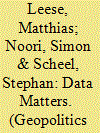| Srl | Item |
| 1 |
ID:
184309


|
|
|
|
|
| Summary/Abstract |
Data matter more than ever in the regulation of borders and migration. An apt illustration of how movement is enabled or restricted by data collection and analytics was recently reported by Eyal Weizman, founding director of the London-based research agency Forensic Architecture that specialises in the production and analysis of evidence about human rights violations by state and corporate actors. Prior to a business trip to Miami where he was supposed to open Forensic Architecture’s first major exhibition in the US that, among other things, displayed investigations into a CIA drone strike in Pakistan and police killings of black US citizens, Weizmann was notified that his visa waiver request had been denied and that he would not be allowed to enter the United States.
|
|
|
|
|
|
|
|
|
|
|
|
|
|
|
|
| 2 |
ID:
188517


|
|
|
|
|
| Summary/Abstract |
In recent years, practices of control at EU border crossing points have been progressively transferred to electronic gates, or what is often called Automated Border Control (ABC). In this paper, I unpack ABC’s infrastructure and argue that e-gates enact three distinct modes of suspicion: First, they address the mistrust towards travellers’ identity claims and promise to better detect identity fraud and the misuse of other persons’ ID documents. Second, they replace the manual work of border guards, which has itself been suspected of being unreliable and error-prone. Third, however, ABC has also raised suspicion among border guards and data protection advocates alike, due to its opaque mode of operation. To examine how these three modes of suspicion unfold, I first show that automating border control relies on a heterogeneous entanglement of material devices, calculative practices and new forms of data. Drawing on document analysis and participant observation of ABC, I then trace the socio-technical controversies that its proliferation has sparked, arguing that e-gates have significantly reconfigured how suspicion at the EU borders is enacted and led to a multiplication of mistrust in the European border regime.
|
|
|
|
|
|
|
|
|
|
|
|
|
|
|
|